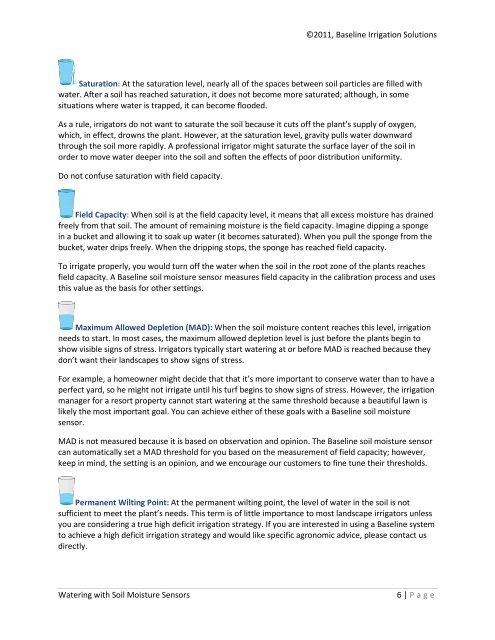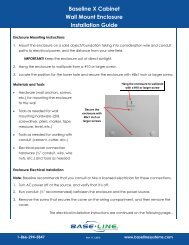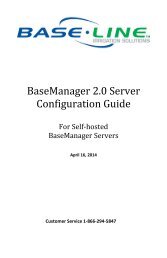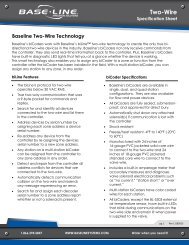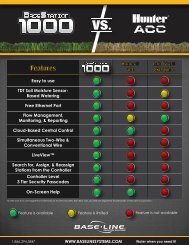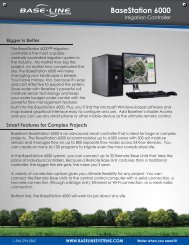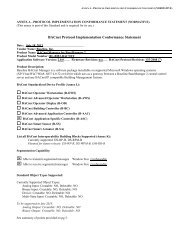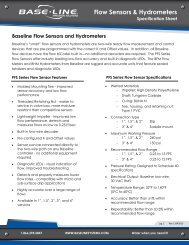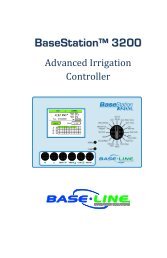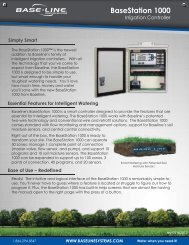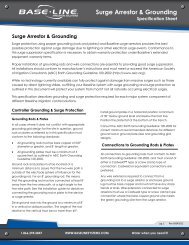Watering with Soil Moisture Sensors - Baseline Systems
Watering with Soil Moisture Sensors - Baseline Systems
Watering with Soil Moisture Sensors - Baseline Systems
You also want an ePaper? Increase the reach of your titles
YUMPU automatically turns print PDFs into web optimized ePapers that Google loves.
©2011, <strong>Baseline</strong> Irrigation SolutionsSaturation: At the saturation level, nearly all of the spaces between soil particles are filled <strong>with</strong>water. After a soil has reached saturation, it does not become more saturated; although, in somesituations where water is trapped, it can become flooded.As a rule, irrigators do not want to saturate the soil because it cuts off the plant’s supply of oxygen,which, in effect, drowns the plant. However, at the saturation level, gravity pulls water downwardthrough the soil more rapidly. A professional irrigator might saturate the surface layer of the soil inorder to move water deeper into the soil and soften the effects of poor distribution uniformity.Do not confuse saturation <strong>with</strong> field capacity.Field Capacity: When soil is at the field capacity level, it means that all excess moisture has drainedfreely from that soil. The amount of remaining moisture is the field capacity. Imagine dipping a spongein a bucket and allowing it to soak up water (it becomes saturated). When you pull the sponge from thebucket, water drips freely. When the dripping stops, the sponge has reached field capacity.To irrigate properly, you would turn off the water when the soil in the root zone of the plants reachesfield capacity. A <strong>Baseline</strong> soil moisture sensor measures field capacity in the calibration process and usesthis value as the basis for other settings.Maximum Allowed Depletion (MAD): When the soil moisture content reaches this level, irrigationneeds to start. In most cases, the maximum allowed depletion level is just before the plants begin toshow visible signs of stress. Irrigators typically start watering at or before MAD is reached because theydon’t want their landscapes to show signs of stress.For example, a homeowner might decide that that it’s more important to conserve water than to have aperfect yard, so he might not irrigate until his turf begins to show signs of stress. However, the irrigationmanager for a resort property cannot start watering at the same threshold because a beautiful lawn islikely the most important goal. You can achieve either of these goals <strong>with</strong> a <strong>Baseline</strong> soil moisturesensor.MAD is not measured because it is based on observation and opinion. The <strong>Baseline</strong> soil moisture sensorcan automatically set a MAD threshold for you based on the measurement of field capacity; however,keep in mind, the setting is an opinion, and we encourage our customers to fine tune their thresholds.Permanent Wilting Point: At the permanent wilting point, the level of water in the soil is notsufficient to meet the plant’s needs. This term is of little importance to most landscape irrigators unlessyou are considering a true high deficit irrigation strategy. If you are interested in using a <strong>Baseline</strong> systemto achieve a high deficit irrigation strategy and would like specific agronomic advice, please contact usdirectly.<strong>Watering</strong> <strong>with</strong> <strong>Soil</strong> <strong>Moisture</strong> <strong>Sensors</strong>6 | P age


